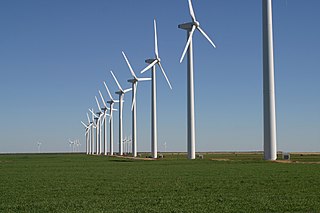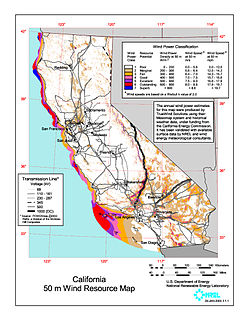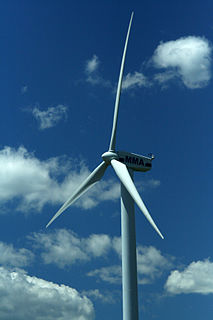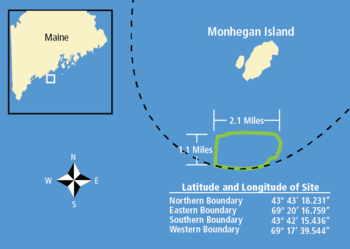
Wind power is a branch of the energy industry that has expanded quickly in the United States over the last several years. From January through December 2021, 379.8 terawatt-hours were generated by wind power, or 9.23% of all generated electrical energy in the United States. The average wind turbine generates enough electricity in 46 minutes to power the average American home for one month. In 2019, wind power surpassed hydroelectric power as the largest renewable energy source generated in the U.S.

Wind power in California had initiative and early development during Governor Jerry Brown's first two terms in the late 1970s and early 1980s. The state's wind power capacity has grown by nearly 350% since 2001, when it was less than 1,700 MW. In 2016, wind energy supplied about 6.9% of California's total electricity needs, or enough to power more than 1.3 million households. Most of California's wind generation is found in the Tehachapi area of Kern County, California, with some large projects in Solano, Contra Costa and Riverside counties as well. California is among the states with the largest amount of installed wind power capacity. In recent years, California has lagged behind other states when it comes to the installation of wind power. It was ranked 4th overall for wind power electrical generation at the end of 2016 behind Texas, Iowa, and Oklahoma. As of 2019, California had 5,973 megawatts (MW) of wind power generating capacity installed.

A floating wind turbine is an offshore wind turbine mounted on a floating structure that allows the turbine to generate electricity in water depths where fixed-foundation turbines are not feasible. Floating wind farms have the potential to significantly increase the sea area available for offshore wind farms, especially in countries with limited shallow waters, such as Japan, France and US West coast. Locating wind farms further offshore can also reduce visual pollution, provide better accommodation for fishing and shipping lanes, and reach stronger and more consistent winds.
There are a number of wind power projects in the state of Maine, totaling more than 900 megawatts (MW) in capacity. In 2020 they were responsible for 24% of in-state electricity production. In 2019, Maine had more wind capacity than the other five New England states combined, at 923 MW.
New York ranked 11th in the United States at the end of 2013 for installed wind power capacity, with 1,722 MW installed. In 2016, wind power provided 2.94% of in state energy production. This increased to 3.66% in 2019.
Ørsted U.S. Offshore Wind is an offshore wind energy development group that is affiliated with Ørsted, a Danish firm. It is joint headquartered in Boston, Massachusetts and Providence, Rhode Island. As of 2019, it was involved in some of the largest offshore wind farm projects in the United States.

Alpha Ventus Offshore Wind Park is Germany's first offshore wind farm. It is situated in the North Sea 45 kilometres (28 mi) north of the island of Borkum.

The U.S. state of Massachusetts has vast wind energy resources offshore, as well as significant resources onshore. The 2016 update to the states's Clean Energy and Climate Plan had a goal of reducing 1990 baseline greenhouse gas emissions levels by 25% by 2020. Current goals include installing 3,500 megawatts (MW) of offshore wind power in the state by 2035. However, as of Q4 2021 the state had only 120 MW of wind powered electricity generating capacity, responsible for generating 0.9% of in-state electricity production. The state has awarded contracts to two offshore projects, the 800 MW Vineyard Wind project and 804 MW Mayflower Wind project. Construction began on the Vineyard Wind 1 project on November 18, 2021, after a long fight for approval.
Wind power in New Jersey is in the early stages of development. As of 2022, New Jersey has just six wind turbines, but the state has plans to develop several major offshore wind projects on the continental shelf of the Atlantic Ocean off the southern Jersey Shore. Legislation has been enacted to support the industry through economic incentives and to permit wind turbines on existing piers.

The potential of on-shore wind power in Delaware is minimal, having a potential of generating at most 22 GWh/year. Delaware's principal wind potential is from offshore wind. A 2012 assessment estimates that 15,038 MW of offshore wind turbines could generate 60,654 GWh/year. Delaware generated 11,522 GWh from all generating sources in 2011.

Block Island Wind Farm is the first commercial offshore wind farm in the United States, located 3.8 miles (6.1 km) from Block Island, Rhode Island in the Atlantic Ocean. The five-turbine, 30 MW project was developed by Deepwater Wind. Construction began in 2015 and in late summer 2016 five Alstom Haliade 150-6-MW turbines were erected. Operations were launched in December 2016. It is the largest project using wind power in Rhode Island.

Wind power in Virginia is in the early stages of development. In March 2015, Virginia became the first state in the United States to receive a wind energy research lease to build and operate offshore wind turbines in federal waters. As of 2019, Virginia had no utility scale wind farms.

Wind power in Maryland, which has land-based and offshore resources, is in the early stages of development. As of 2016, Maryland has 191 megawatts (MW) of wind powered electricity generating capacity, responsible for 1.4% of in-state generated electricity. Two offshore wind farm projects that will supply wind-generated power to the state are underway.
The DeepCwind Consortium is a national consortium of universities, nonprofits, utilities, and industry leaders. The mission of the consortium is to establish the State of Maine as a national leader in floating offshore wind technology. Much of the consortium's work and resulting research has been funded by the U.S. Department of Energy, the National Science Foundations, and others.

The Advanced Structures and Composites Center is an independent research unit at the University of Maine that provides research, education, and economic development encompassing material sciences, manufacturing and engineering of composites and structures.

The VolturnUS is a floating concrete structure that supports a wind turbine, designed by University of Maine Advanced Structures and Composites Center and deployed by DeepCwind Consortium in 2013. The VolturnUS can support wind turbines in water depths of 150 ft (46 m) or more. The DeepCwind Consortium and its partners deployed a 1:8 scale VolturnUS in 2013. Efforts are now underway by Maine Aqua Ventus 1, GP, LLC, to deploy to full-scale VolturnUS structures off the coast of Monhegan Island, Maine, in the UMaine Deepwater Offshore Wind Test Site. This demonstration project, known as New England Aqua Ventus I, is planned to deploy two 6 MW wind turbines by 2020.
Skipjack is a 120 MW capacity off shore wind farm, proposed by Ørsted US Offshore Wind to be built on the Outer Continental Shelf Offshore Delaware, approximately 16.9 nautical miles-19.5 miles (31.4 km) from the coast opposite Fenwick Island. It is projected that the project, which will provide power to Maryland, will be commissioned in 2022. It is one of two offshore wind farm projects providing wind power to Maryland, the other being Marwind.
South Fork Wind Farm is a utility-scale offshore wind farm currently being constructed on the Outer Continental Shelf Offshore Rhode Island (RI) which will provide energy to New York state.
The Coastal Virginia Offshore Wind (CVOW) is an offshore wind energy project located about 43 km off the coast of Virginia Beach, Virginia, U.S. The initial phase, a two-turbine, 12-MW pilot project constructed in 2020, is the second utility scale offshore wind farm operating in the United States. Dominion Energy and Ørsted US Offshore Wind collaborated on the project, which is estimated to have cost $300 million and is expected to generate enough electricity to power up to 3,000 homes. It is the first utility scale wind farm serving Virginia and the first built in U.S. federal waters, in a wind lease area that covers about 2,135 acres.












